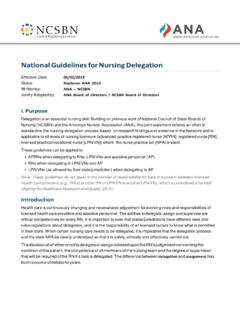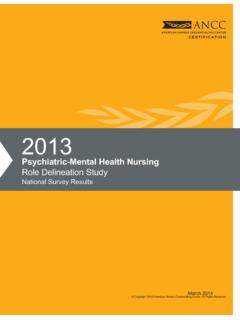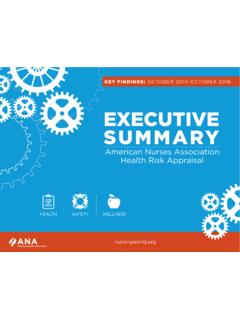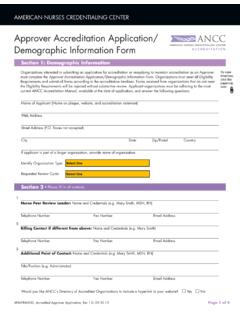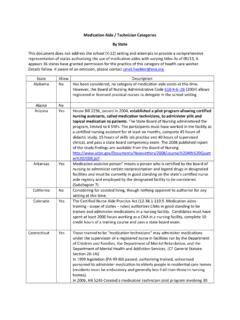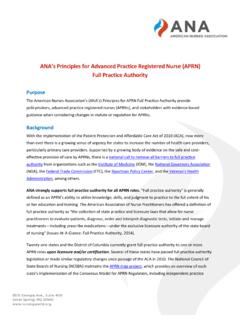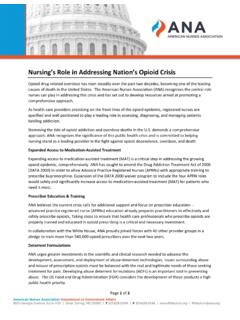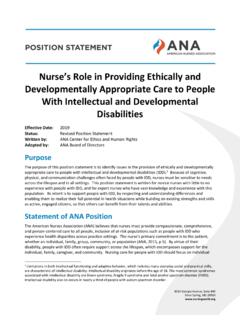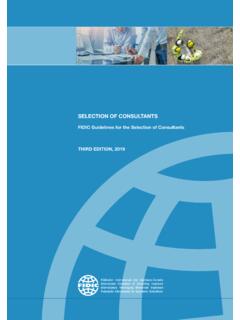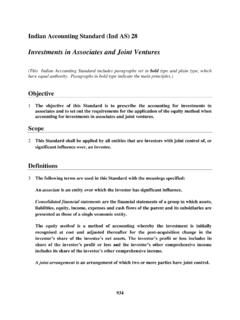Transcription of ANA ISSUE BRIEF - American Nurses Association
1 Page 1 of 7 2010 ANA All Rights Reserved ANA ISSUE BRIEF Information and analysis on topics affecting Nurses , the profession and health care. Evolving Models of Care Delivery The Patient Protection and Affordable Care Act of 2010 (PPACA) contains many provisions that seek to intertwine the quality of care with the cost of care. This is a response, in part, to research demonstrating that a single focus on reducing cost is not enough. Rather one must ask what we are purchasing with each health care dollar, and how that investment contributes to improved health for individuals and populations. The current system is fragmented, without any single entity responsible for the overall quality and coordination of the patient s care. You get what you pay for, and, in health care, the fee-for-service system has directed the larger share of resources to procedures, tests, and acute care.
2 By creating incentives for integrated care delivery models and paying for coordination and quality of care, the law seeks to rebalance the system s resource allocation and reward the value of care over volume of care. Answering a need: Nurses leadership and contributions Registered Nurses are fundamental to the success of emerging patient-centered care delivery models. PPACA directs renewed attention and substantially more resources and incentives to promote those elements of care which are also the backbone of nursing practice. These essentials of nursing practice include patient-centered or holistic care, including family and community; care continuity; coordination and integration across settings and providers; chronic disease management; patient education; prevention and wellness care; and information management. In addition, PPACA recognizes the advance practice registered nurse (APRN) as a valuable provider of primary care services, as well as a potential leader in new integrated care systems.
3 The Institute of Medicine defines primary care as the New Care Delivery Models in Health System Reform: Opportunities for Nurses & their Patients Key Points Nurses education, skills and professional scope make them indispensible contributors to successful implementation of evolving patient centered care delivery models. Accountable Care Organizations (ACOs), Medical/health homes, and nurse -managed Health Clinics are three of the varied approaches to coordinated care. Health reform opens the door to a more central role for APRNs in the creation, leadership and management of new and innovative patient-Page 2 of 7 2010 ANA All Rights Reserved The ACO is basically a collaboration among primary care clinicians, a hospital, specialists and other health professionals who accept joint responsibility for the quality and cost of care provided to its patients.
4 Provision of integrated, accessible health care services by clinicians who are accountable for addressing a large majority of personal health care needs, developing a sustained partnership with patients, and practicing in the context of family and community. i The nursing community s robust advocacy assured that this definition was adopted in PPACA, opening the door to a more central role for APRNs in the creation, leadership and management of new and innovative patient-centered care systems. Three emerging care delivery models, in particular, are addressed in PPACA. These are the accountable care organization, the medical or health home, and the nurse -managed health center. Each is discussed in greater detail below. Accountable Care Organizations (ACOs) What is an ACO? The ACO, in its most basic form, is a collaboration among primary care clinicians, a hospital, specialists and other health professionals who accept joint responsibility for the quality and cost of care provided to its patients.
5 If the ACO meets certain quality and savings targets, its members receive a financial bonus. under PPACA, the ACO is a creature of Medicare, and the cost targets are termed shared savings allocated between the ACO and the Medicare program. The ACO is a group of providers of services and suppliers that promotes accountability for a patient population and coordinates items and services under [Medicare] parts A and B, and encourages investment in infrastructure and redesigned care processes for high quality and efficient service delivery. (PPACA, Section 3022).ii If the ACOs meets quality performance standards (established by the HHS Secretary), they are eligible to receive payments for shared savings. The law also establishes a demonstration project for Medicaid pediatric ACOs. How are ACOs organized? Some important existing models of ACOs influenced the provision that appears in PPACA; those early versions tend to be hospital- or physician-centered.
6 PPACA provides more leeway in terms of who can lead an ACO, permitting greater nursing leadership, as well as participation. A key term in the law with special significance for advance practice nursing is ACO professional, because these are the individuals who can organize and provide leadership within the ACO. They also share in the financial risk or reward. They may be ACO professionals in group practice arrangements, Page 3 of 7 2010 ANA All Rights Reserved The statutory requirements that ACOs must meet suggest that the services and care provided by registered Nurses will be essential to the success of ACOs. networks of individual practices of ACO professionals, partnerships or joint venture arrangements between hospitals and ACO professionals, and/or hospitals employing ACO The law defines ACO professional as a physician and a practitioner [further defined as nurse Practitioners, Clinical nurse Specialists or Physician Assistants].
7 Iv The and is vague, and it could arguably be read either that both can independently be ACO professionals, or that one must have a physician and any of the other practitioners to form an ACO. The definition of practitioners does not include CNMs or CRNAs; however, the HHS Secretary may designate other groups of providers of services and suppliers as deemed appropriate. There are also some private projects underway that would expand the ACO beyond Medicare. The Dartmouth Institute for Health Policy and Clinical Practice, and the Engelberg Center for Health Care Reform at the Brookings Institution, are two leaders advocating for a physician-centered They have a pilot project testing the model with private payers, and possibly Medicaid, in several geographic settings and among health care entities with different levels of integration, set to begin in 2010.
8 One of the hurdles they have to clear is figuring out how to coordinate the quality targets and cost-sharing among the number of private insurers that would be implicated. What are Nursing s opportunities? The law s focus on seeking value in care delivery points to a heavy reliance on nursing services and care. As noted earlier, nursing s scope of practice embraces the means and goals of new delivery models, such as ACOs. The statutory requirements that ACOs must meet suggest that the services and care provided by registered Nurses , in general, will be essential to the success of These include the following: An ACO must be willing to become accountable for the quality, cost, and overall care of the Medicare fee-for-service beneficiaries assigned it. It must include primary care ACO professionals sufficient for the number of Medicare fee-for-service beneficiaries assigned to the ACO, of which there must be a minimum of 5,000 to be eligible.
9 It must define processes to promote evidence-based medicine and patient engagement, report on quality and cost measures, and coordinate care, including the use of telehealth, remote patient monitoring, and other enabling technologies. Lastly, it must meet patient-centeredness criteria specified by HHS, such as the use of patient and caregiver assessments or the use of individualized care plans. Page 4 of 7 2010 ANA All Rights Reserved The medical home can be understood as a mechanism to provide patients with a central primary care practice or provider who coordinates the patients care across settings and providers. In addition, registered Nurses would have the opportunity to collaborate with primary care nurse providers on coordinated care plans for patients. nurse Practitioners and Clinical nurse Specialists have chance to provide significant organizational leadership within the ACO model, particularly in providing care in underserved areas.
10 If nursing can present a patient-centered, nurse -led model to HHS early in the process, and importantly can demonstrate savings, nursing may have much to benefit from the ACO model. It would create a situation where more data could be collected regarding the quality and efficacy of nurse -led care and, in the best scenario, would create a continuous feedback loop supporting such nurse -led models. Medical/health homes What is a medical or health home? In general, the medical home (or health home both terms are used) can be understood as a mechanism to provide patients with a central primary care practice or provider who coordinates the patients care across settings and providers. This might be promoted through a capitated payment or other financial incentive to providers to encourage preventive care and chronic care management, as well as reduce reliance on specialist and emergency care.
